Posted by Anita on 05.06.07 11:00 PM
 If you’ve spent any time on food blogs, I’m sure you know Barbara of Winos & Foodies — the creator of one of my favorite blog events, Hay Hay, It’s Donna Day. Barbara asked her food-blogging friends to participate in a new blog event called A Taste of Yellow by preparing a dish containing some type of yellow food. On May 16 — in honor of the Lance Armstrong Foundation’s LIVESTRONG Day — Barbara will post a roundup of the Taste of Yellow posts. She’s collected almost 30 so far!
If you’ve spent any time on food blogs, I’m sure you know Barbara of Winos & Foodies — the creator of one of my favorite blog events, Hay Hay, It’s Donna Day. Barbara asked her food-blogging friends to participate in a new blog event called A Taste of Yellow by preparing a dish containing some type of yellow food. On May 16 — in honor of the Lance Armstrong Foundation’s LIVESTRONG Day — Barbara will post a roundup of the Taste of Yellow posts. She’s collected almost 30 so far!
Our entry for A Taste of Yellow has languished in my “to try” file for a while, and I wish we’d made it sooner. It turned out to be so easy and tasty, it’s sure to become a standby in our house. In honor of Barbara’s New Zealand locale, we served the yellow potatoes alongside grilled lamb chops (in a yellow curry sauce, just to be double-sure we had the theme covered). Both the curry and the potato recipe came from the Vij’s cookbook, which you may remember from the gorgeous paneer dish we mentioned last month.
Turmeric offers many health-giving effects. The ginger-like rhizome has been used medicinally in traditional Asian and Indian practice for centuries. It acts as an anti-inflammatory and antibacterial agent, and its antioxidant properties have been shown to prevent free-radical damage that’s been linked to cancer. In laboratory tests, turmeric’s active ingredient has decreased symptoms of skin cancers, and reduced the incidence of chemically caused breast cancer in laboratory animals. Three current clinical trials at the US National Institutes of Health are targeting pancreatic cancer, multiple myeloma, and colorectal cancer using turmeric’s main compounds.
And, of course, it’s a gorgeous shade of yellow.
 Vij’s Turmeric Potatoes
Vij’s Turmeric Potatoes
1 pound yellow new potatoes
2 T canola oil
3/4 cup chopped onion (1/2 large onion)
1/2 tsp turmeric
1-1/2 tsp salt
1/4 tsp cayenne pepper
2 T water
3 oz baby spinach
Wash and scrub the potatoes, but do not peel them. Cut each potato in 1/4-inch rounds using a food processor or mandoline.
Heat oil in a heavy frying pan on medium heat for 1 minute. Add onions and saute for 5 minutes, or until golden. Add turmeric, salt, and cayenne; stir well and cook for 1 minute.
Add potatoes and water, and bring to a light boil. Gently stir the potatoes. Reduce heat to low, cover, and cook for about 10 minutes. If the potatoes stick or begin to burn, add another 2 T water. Gently stir the potatoes again. Cover and cook another 4 minutes, or until potatoes are almost done, but not too soft. Add the spinach, cover, and cook for 1 minute longer.
cookbooks, cooking, other blogs, recipes
6 Comments »




Posted by Anita on 04.26.07 12:15 PM
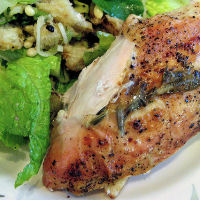 Here I was, feeling all smug about having cooked and eaten six days worth of local, affordable, and (dare I brag?) delicious food for the Penny-Wise Eat Local Challenge. And then I read CookieCrumb’s post about eating wheatberries to keep your carbs up… and instantly felt terribly guilty about all the bread we’ve eaten this week. But damn, this challenge was hard enough, even with all of the exemptions we claimed.
Here I was, feeling all smug about having cooked and eaten six days worth of local, affordable, and (dare I brag?) delicious food for the Penny-Wise Eat Local Challenge. And then I read CookieCrumb’s post about eating wheatberries to keep your carbs up… and instantly felt terribly guilty about all the bread we’ve eaten this week. But damn, this challenge was hard enough, even with all of the exemptions we claimed.
Every time I reached for a bottle of soy sauce or a pinch of chile, I repeated to myself a favorite quote from the Chronicle article profiling Cookie and her husband Cranky’s early take on the challenge: “One of the things you learn when you do this is that [eating] local is not a cult,” says [Cranky]. “You learn about things and you make exceptions.”
Keeping what I now call “The Cranky Principle” in mind, I’m proud of our results. We certainly did well in the budget department: Our 6-day food expenditures came to $123.73 — equivalent to $144.35 for a 7-day week, or just 35 cents over budget. (If you’re curious about all the gory details, feel free to peek at the spreadsheet, which also details the distance the food travelled to our plates. Oh, and there are some pictures — obviously not everything we ate is here, but it’s a good assortment.)
A few observations on our week:
We ate about the same quantity of food as usual, and about the same protein-to-carbs ratio. We ate more ground meat than we do in a typical week, although in truth I think that if I had had more time to plan my menu, and more time to shop around, could have done better in this regard.
 I bought more food at the grocery store than I usually do, and less from the farmers market. Sad to say, the ‘Big Organic’ producers like Earthbound Farms make it hard to walk by that $3 bag of (four!) romaine hearts when the budget’s tight. When it came down to it, I suspected the premium for farm-fresh produce would eat into the budget. I’ll be glad to leave the shrinkwrapped lettuce behind next week, though, and go back to my delicate Little Gems.
I bought more food at the grocery store than I usually do, and less from the farmers market. Sad to say, the ‘Big Organic’ producers like Earthbound Farms make it hard to walk by that $3 bag of (four!) romaine hearts when the budget’s tight. When it came down to it, I suspected the premium for farm-fresh produce would eat into the budget. I’ll be glad to leave the shrinkwrapped lettuce behind next week, though, and go back to my delicate Little Gems.
We didn’t do as good a job of eating seasonally as we could have. I’ll chalk some of this up to my not planning ahead sufficiently — we jumped into the challenge with less than 24 hours’ notice — but a lot of it did come down to the fact that the things we like to eat at this time of year aren’t terribly cheap, yet. So I fell back on a lot of the foods I used to make when money was tighter: Roast chicken, meatloaf, sandwiches, stir-fries… and lots of leftovers for lunch.
Speaking of lunch: Forgetting your brown bag can be disastrous. I left my chicken-salad sandwich in the fridge at home on Tuesday! Luckily, a short streetcar ride put me at the Ferry Building, where the Tuesday lunchtime market meant I had my choice of Donna’s tamales (too long a line), Prather or Taylor’s burgers (too pricey), Acme ‘sandwiches’ (too skimpy!), and Mijita’s chilaquiles. Guess which one this Mexican-breakfast addict chose? At $7 a plate, they’re not a bargain, but compared to Mijita’s other choices, they’re a steal. My forgetfulness did bust the budget, but only by the teensiest bit.
 Our revised alcohol budget of $9.75 per week for two people still seems incredibly low. We went to 150% of budget and spent $14, which bought us a six-pack of Speakeasy Untouchable Pale Ale and a 375 ml half-bottle of Bonny Doon Big House Red. And yes, we found ourselves standing in front of the fridge pondering the empty booze shelf by the middle of the week. Next time, maybe we’ll buy a big bottle of Anchor’s Old Potrero Rye and drink a fifth of it — very slowly — mixed with good ol’ Hetch-Hetchy branch water. (Doesn’t sound very food-friendly, does it?)
Our revised alcohol budget of $9.75 per week for two people still seems incredibly low. We went to 150% of budget and spent $14, which bought us a six-pack of Speakeasy Untouchable Pale Ale and a 375 ml half-bottle of Bonny Doon Big House Red. And yes, we found ourselves standing in front of the fridge pondering the empty booze shelf by the middle of the week. Next time, maybe we’ll buy a big bottle of Anchor’s Old Potrero Rye and drink a fifth of it — very slowly — mixed with good ol’ Hetch-Hetchy branch water. (Doesn’t sound very food-friendly, does it?)
I definitely enjoyed taking part in the challenge. Even though most of our food already came from local or semi-local sources, participating here opened my eyes to both the variety of items in our foodshed, and the distances that even our ‘local’ farmers market food travels to get to our kitchen. I have to admit that I’m looking forward to being able to just shop and cook from the hip, without taking notes or making calculations. And I know that despite all of the ways we stretched the rules, we learned a lot.
Most of the participants are just past the halfway mark of their challenge — we started early and shortened our week to 6 days due to a previous dinner commitment tonight and a weekend full of travel. For an amazing peek into the nuts and bolts of eating locally, check out all 20 of the participating bloggers over on the PELC roundup page. I’m utterly in awe of folks who are giving this a go in places like Maine and Syracuse, where spring has just barely sprung.
cooking, farmers markets, locavore, other blogs, shopping
Comments Off on Our Penny-Wise week




Posted by Anita on 04.20.07 10:47 PM
 After much hemming and hawing, I decided there aren’t enough good reasons not join in next week’s Penny-Wise Eat Local Challenge. So, we’ve committed to spend a week — or, in our case, six days — eating as much as we can from within our foodshed.
After much hemming and hawing, I decided there aren’t enough good reasons not join in next week’s Penny-Wise Eat Local Challenge. So, we’ve committed to spend a week — or, in our case, six days — eating as much as we can from within our foodshed.
As if consuming foods grown or produced exclusively within a short radius of our home wasn’t hard enough, we’re also doing it on less than $144 a week, plus a mere $8 (!) for alcohol, in an effort to prove that it’s possible to be a locavore without spending any more than the average American two-person, two-earner family.
Coming from our house, where we have been known to spend $144 on a single dinner and $8 on one cocktail, this is going to be …interesting. But luckily, we have a gorgeous new kitchen where we love to cook these days. As for dining out, that’s one reason for our loose interpretation of the challenge week (the official start of the event isn’t until Monday the 23rd): We’re attending a benefit for a very worthy cause on Thursday night, and it doesn’t feel right to pinch pennies under the circumstances.
I’ve also done my best to plan meals for this week that are within the grasp of the average American home cook, both in terms of technique and ingredients. I’ve got a serious edge, living in the Bay Area, where we have so many great local artisans and farmers within close reach, so I didn’t want to stack the deck any further by choosing esoteric items or high-falutin’ preparations.
As far as exemptions go, I am allowing myself the so-called “Marco Polo rule”: I’m not tying myself to local spices, nor small quantities of condiments. Cameron’s going to continue to drink his coffee (it’s from Peet’s, a local establishment) and I feel no need to abandon my nasty Fresca habit. We’ll add the cost of these items to our budget, as well as any other non-local items we consume. We’re also buying bread that I have to assume is baked with non-local flour, but at least we’ll be supporting local artisans.
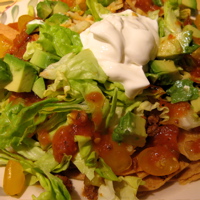 And because some of our favorite items come from slightly further afield, we’re going to extend our challenge radius to 200 miles, from the standard 100. But mostly, when we have a choice, we’ll opt for a product grown or made as close to us as possible. We’ll also be using fruits and herbs from our own garden, so perhaps that will keep our average distance down.
And because some of our favorite items come from slightly further afield, we’re going to extend our challenge radius to 200 miles, from the standard 100. But mostly, when we have a choice, we’ll opt for a product grown or made as close to us as possible. We’ll also be using fruits and herbs from our own garden, so perhaps that will keep our average distance down.
Tonight’s dinner was an old favorite, a taco-salad-like dish known in my family as “Walking Tostadas.” I sauteed some ground beef in a skillet, added some taco seasonings and a pureed tomato, and simmered. On the plate, the dish is simply a handful of broken tortilla chips, topped with the taco meat, then some shredded cheese, lettuce, salsa, tomatoes, avocado, and sour cream.
Here’s how it breaks down…
chips: 1/6 of a bag from Rancho Gordo (Napa / 50 mi) — $1
ground beef: 1 pound Prather Ranch (Shasta / 200 mi)– $6
tomato for puree: Whole Foods “locally grown” (Dinuba / 200 mi) — $0.66
lettuce: 1/2 of a romaine heart: Earthbound Farms (SJ Bautista / 88 mi) — $0.50
cheese: 1/2 wedge raw-milk chipotle cheddar Bravo Farms (Traver / 225 mi) — $1.50
crema: 2oz creme fraiche Bellwether Farms (Tomales / 50 mi) — $1.33
salsa: 2oz prepared Primavera (Sonoma / 50 mi) — $1
avocado: 1/2 a small one, part of a $3 grab bag from Will’s (Soledad / 130 mi) — $0.50
grape tomatoes: 1/6 of a large bunch from Balakian Farms (Reedly / 200 mi) — $0.50
(edit: The grape tomatoes were from Bruin Farms in Winters, 65 miles away)
Total this meal: $12.49 with plenty of leftover meat
I’m not going to go into this level of detail all week, I promise. But so far, I’ve estimated we’ll spend a good bit under our budget. Tomorrow’s trip to the farmers market will be the real test, but the most expensive items — meat and cheeses — are very predictable.
cooking, farmers markets, garden, locavore, other blogs, shopping
4 Comments »




Posted by Cameron on 04.18.07 9:47 PM
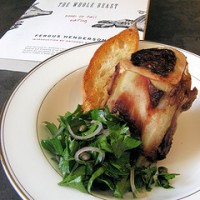 “I got nasty habits, I take tea at three
“I got nasty habits, I take tea at three
Yes and the meat I eat for dinner
Must be hung up for a week”
–“Live With Me,” The Rolling Stones
Quick flashback to five years ago, just before we became legally married with dinner. We relate our honeymoon plans to friends and acquaintances and are met with raised eyebrows and a single repeated question:
“You’re going to England for two weeks? What are you going to eat?”
Everything that we could fit in, thank you very much, and the list was longer than we’d have time or money for. Every Real Ale pub within reach of the Underground. Boxwood Cafe. Pork and stilton breakfast sandwiches from the Borough Market, washed down with Monmouth Coffee. Cheese from Neals Yard Dairy. English breakfast, bangers please. Eton Mess. Branston Pickle. Chip shops. Eccles cakes. Pret a Manger. McVitties. Packaged meals from London groceries as good or better than you could make with fresh ingredients.
 But the meal that I was not-so-secretly looking forward to the most was dinner at St. John Bar and Restaurant. It was food that (at the time) I could only find in England. Every possible part of some ridiculously tasty animal prepared and served practically unadorned. Anita still wakes with a start from dreams of Middlewhite pork. Here I found what I adore about English cuisine: naked love for animal fat, roasted flesh, organ meats, connective tissue, and wild things from the hunt. Pig tails, venison, game birds, sliced roast beef, Yorkshire pudding.
But the meal that I was not-so-secretly looking forward to the most was dinner at St. John Bar and Restaurant. It was food that (at the time) I could only find in England. Every possible part of some ridiculously tasty animal prepared and served practically unadorned. Anita still wakes with a start from dreams of Middlewhite pork. Here I found what I adore about English cuisine: naked love for animal fat, roasted flesh, organ meats, connective tissue, and wild things from the hunt. Pig tails, venison, game birds, sliced roast beef, Yorkshire pudding.
And beef marrow. Have mercy, the beef marrow.
Roast Bone Marrow and Parsley Salad
from The Whole Beast: Nose to Tail Eating, by Fergus Henderson
(note: this recipe captures just a bit of Chef Henderson’s calm, dry voice and humor. The actual cookbook is as entertaining to read as it is to use. Plus, who else is going to tell you how to deep-fry lamb’s brains?)
– serves four
twelve 3-inch pieces of veal marrowbone
a healthy bunch of flat-leaf parsely, leaves picked from the stems
2 shallots, peeled and very thinly sliced
1 modest handful of capers (extra-fine if possible)
Dressing:
juice of 1 lemon
extra-virgin olive oil
a pinch of sea salt and freshly ground pepper
a good supply of toast
coarse salt
Put the marrowbone pieces in an ovenproof frying pan and place in a hot 450 degree (F) oven. The roasting process should take about 20 minutes depending on the thickness of the bone. You are looking for the marrow to be loose and giving, but not melted away, which it will do if left too long (traditionally the ends would be covered to prevent any seepage, but I like the coloring and crispness at the ends).
Lightly chop your parsley, just enough to discipline it, mix it with the shallots and capers, and at the last moment, dress the salad.
Here is a dish that should not be completely seasoned before leaving the kitchen, rendering a last-minute seasoning unnecessary by the actual eater; this, especially in the case of coarse sea salt, gives texture and uplift at the moment of eating. My approach is to scrape the marrow from the bone onto the toast and season with coarse sea salt. Then a pinch of parsley salad on top of this and eat. Of course once you have your pile of bones, salad, toast, and salt it is diner’s choice.
English food is not a joke because nose to tail eating is serious business.
This post is part of the Fish & Quips event hosted by Becks & Posh, in honor of St. George’s Day.
cookbooks, cooking, holidays & occasions, meat, other blogs, recipes, travel
9 Comments »




Posted by Anita on 04.09.07 6:07 PM
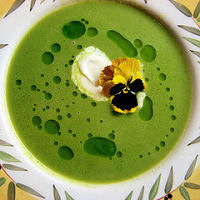 The gorgeous soup we served for Easter-eve supper — as a first course before a tried-and-true potato gratin and a succulent Fatted Calf Petit Jamon — is an old Soup of the Fortnight favorite. But last time I wrote about it, I only linked to the original recipe (which serves 16+!) and didn’t include a photo. As you can see, it’s a soup that looks much more elegant in the bowl than it sounds from a simple reading.
The gorgeous soup we served for Easter-eve supper — as a first course before a tried-and-true potato gratin and a succulent Fatted Calf Petit Jamon — is an old Soup of the Fortnight favorite. But last time I wrote about it, I only linked to the original recipe (which serves 16+!) and didn’t include a photo. As you can see, it’s a soup that looks much more elegant in the bowl than it sounds from a simple reading.
The recipe made its debut a year ago in Seattle, at a dinner organized by a group of MouthfulsFood friends to celebrate the start of spring. We weren’t able to make it to that dinner, but the recipe sounded so amazing, I couldn’t wait to try it. I whipped up a batch for a dinner party a few days later, including the chive oil and the lemon creme fraiche — touches I probably wouldn’t have bothered with for an everyday meal. But, as I learned, it would not be wise to skip them: Unlike many garnishes, they’re the crowning glory of this soup, elemental pieces whose presence would be sorely missed in the end result.
Jan’s Spring-Green Soup
— serves 6 as a first course
3 cups good quality chicken stock
1 to 2 oz. bacon strips
1T unsalted butter
1/2 white onion, chopped
1 large stalk celery, trimmed well of strings, chopped
2 stalks green garlic or 1 medium leek, washed well (tender parts only), chopped
1 T chopped Italian parsley
2 T dry vermouth
4 oz. fresh sugar snap peas, trimmed and cut in half
1 small head butter lettuce (aka Boston or Bibb lettuce), rinsed well and chopped
3 cups frozen petit pois, thawed (such as C&W Early Harvest Spring Peas)
1 long sprig of fresh rosemary
Salt, to taste
White pepper, to taste
Fresh lemon juice, to taste
1/4 to 1/2 cup heavy cream
Put chicken stock in a large saucepan or small stockpot (at least 4-quart capacity) and bring to a boil. Prepare an ice bath under a large, metal bowl.
Meanwhile, sauté the bacon in a large sauté pan until browned and fat is rendered. Remove strips and put them in the stockpot with the stock. Pour out all but about 1T fat from sauté pan, add 1T butter. Add onions, celery, leeks and rosemary sprig to pan. Stir to combine, add a pinch or two of salt, and sweat for 10 to 15 minutes, being careful not to brown vegetables. Add more pork fat if needed. When soft, add parsley, deglaze the pan with vermouth, and reduce the vermouth briefly. Add these ingredients to the stock.
Bring the stock back to a boil; add the sugar snap peas and cook for about 2 minutes. Add the lettuce, bring back to the boil and cook for 1 to 2 minutes. Add the peas, bring back to the boil, and cook until everything is just tender. The lettuce gets dark and slimy, but don’t fear: All will be well. The peas should still be quite bright green …don’t overcook or it will all turn grey.
When all vegetables are tender, immediately pour the soup into the large bowl over an ice bath and stir to cool. This will keep it from overcooking and darkening. When cooled to room temp, remove rosemary sprig and bacon strips.
Puree the soup with a stick blender (or, using in a traditional blender, in batches) and strain the puree into another pot or bowl. You’ll need to work for a while with a rubber spatula to push the soup out and leave the solids behind. This is one time where pressing hard and stirring around is not just fine but required: You want just the fibers left behind. If you leave too much vegetable matter in the strainer, your soup will be thin, and you won’t have enough to make six servings.
(The soup can be refrigerated at this point for a day or two.)
To serve cold:
Add cream as desired, being careful not to overwhelm the fresh, green flavor. Start with 2T of cream; taste. Adjust seasoning with salt, white pepper, and small amounts of lemon juice.
To serve warm:
Heat soup over medium-low. Add cream as desired, being careful not to overwhelm the fresh, green flavor. Add cream as desired, starting with 1/4 cup; taste. Adjust seasoning with salt, white pepper, and small amounts of lemon juice.
To finish:
Ladle into bowls and add swirls (or a dollop) of lemon crème fraiche and droplets of chive oil. Garnish with an edible flower, if desired.
—-
Lemon Crème Fraiche
1/2 cup crème fraiche
Zest of 1/2 lemon, finely grated
Lemon juice to taste
Salt
Fresh ground pepper
Stir up crème fraiche with drops of lemon juice and some of the zest, starting with about 1 tsp. Add a pinch of salt and a grind of pepper. Taste and adjust amount of lemon juice/zest to taste. If you need to thin more, but don’t want to add more lemon juice, use milk. Put into squeeze bottle or drop by the spoonful into soup.
—-
Chive Oil
1/2 cup oil, preferably mild olive oil
1 bunches chives, cut into thirds (divided use)
Salt to taste
Blanched one third of the chives for 10 seconds and shock in an ice-water bath. Puree the blanched and raw chives in a small blender container with the oil and the salt. Taste for salt, and add more oil if the salt or chive flavor is too strong. Let the puree sit for several hours. Strain twice to remove solids.
holidays & occasions, recipes, Soup o' the Fortnight
13 Comments »




Posted by Anita on 04.05.07 7:45 AM
 You’d think that after torturing myself for three months, poring over recipes that I couldn’t begin to attempt without a proper kitchen, I’d be able to choose one or two candidates from a single cookbook. But there were so many delectable-sounding recipes in the copy of Vij’s: Elegant & Inspired Indian Cuisine that my sister gave me for Christmas, I finally had to force myself to pick a couple at random.
You’d think that after torturing myself for three months, poring over recipes that I couldn’t begin to attempt without a proper kitchen, I’d be able to choose one or two candidates from a single cookbook. But there were so many delectable-sounding recipes in the copy of Vij’s: Elegant & Inspired Indian Cuisine that my sister gave me for Christmas, I finally had to force myself to pick a couple at random.
After much deliberation, I set my sights on a buttermilk curry, which Vij admits “from a visual point of view … won’t win any prizes”. Hey, if a dish is ugly enough to require forewarning, and it still makes the cut for inclusion in your restaurant’s signature cookbook, it must be pretty tasty. And indeed it was: Scented with cloves and cardamom, and thickened with mashed potato, the comforting stew-like dish reminded me of a Thai massaman curry. (No big surprises there, as the Thai dish was originally brought over from either Persia or the Subcontinent, depending on who you ask.)
True to Vij’s disclaimer, it looked for all the world like the stuff you’d scrape off the top of a simmering stock, an unappetizing mass of curdled dairy and greying meat. But inside each bland-looking cube of meat lurked a secret: Vivid, almost violet-hued shreds of beef, meltingly tender and softly perfumed with spices. The sauce, too, came together into something a bit less rotten-looking in the last few minutes of simmering. Although it never turned into the proverbial swan, I suppose I could admit this curry was a slightly less-ugly duckling on the plate than it had been two hours earlier in the pot.
 I don’t think I consciously picked a gorgeous dish for my second recipe, but that’s certainly how Sauteed Greens and Paneer turned out. I hope you won’t think I’m being immodest when I say it looked almost as good on the plate as it did in the cookbook photo; I mean it as a compliment to the recipe, not to my (admittedly weak) food-styling skills. Despite being listed in the book’s appetizers chapter, this savory melange proved plenty rich enough to serve as a very satisfying vegetarian entree, or to divvy up into smaller portions for a true starter.
I don’t think I consciously picked a gorgeous dish for my second recipe, but that’s certainly how Sauteed Greens and Paneer turned out. I hope you won’t think I’m being immodest when I say it looked almost as good on the plate as it did in the cookbook photo; I mean it as a compliment to the recipe, not to my (admittedly weak) food-styling skills. Despite being listed in the book’s appetizers chapter, this savory melange proved plenty rich enough to serve as a very satisfying vegetarian entree, or to divvy up into smaller portions for a true starter.
I’ve been lucky enough to eat at Vij’s famed Vancouver restaurant — and its take-away branch next door, Rangoli — on trips to Vancouver a few years back. Both of these recipes felt true to the flavors and presentations I remember enjoying there, modern Canadian riffs on traditional Indian flavors that somehow managed to avoid the caricature-like glitches that mar most fusion cuisine. Both restaurants seem like the kind of places where we’d eat a lot if we lived nearby, or even if we visited more often. Since a trip to Vancouver isn’t be in the cards for a while, I’m looking forward to delving deeper into this gorgeous collection of recipes. But on the strength of these two dishes alone, this book’s already a keeper.
Please note: The recipes below differ slightly from the published versions, mostly because I scaled them to match the quantities of raw ingredients I had on hand. I also clarified some instructions that I found confusing on the first read-through.
Sauteed Greens with Paneer
14 whole raw unsalted cashews
1/2 pound raw spinach
1/2 pound rapini (aka broccoli raab, choi sum, etc.)
1/4 cup vegetable oil
1-1/2 tsp. cumin seeds
1 cup pureed tomatoes (about 2 medium)
2 tsp. ground black mustard seeds
1/4 tsp ground turmeric
1 tsp. salt
3/4 tsp. cayenne pepper
1 cup water
4 oz. coconut milk, stirred
6 oz. paneer, brought to room temperature
Toast the cashews in the oven (3 minutes at 375, stir, 3 more minutes) or on the stovetop; let cool.
Cut the tougher stems off the spinach and the rapini. Heat oil in large frying pan for 1 minute. Add cumin seeds, stir and allow to sizzle for 30 to 45 seconds. Add tomato puree, mustard seeds, turmeric, salt, and cayenne. Stir and reduce heat to medium-low, then cover and cook for 5 minutes. Remove the lid and stir. The top of the sauce should glisten with oil; if it does not, cook uncovered another 1-2 minutes.
Stir in water and increase heat to medium-high. Bring to a boil, then reduce heat to a steady simmer, and cook for 5 to 8 minutes, until sauce thickens. Add coconut milk, and continue cooking until the mixture starts to simmer briskly. Add greens and cook for 2 minutes or until well wilted, stirring regularly.
Slice the paneer into 4 pieces the long way, then slice each half again to make vaguely square-ish blocks. To serve 2 as a vegetarian entree, place half of the slices in each bowl; to serve 4 as an appetizer, divide among 4 bowls. Using a tongs, place the greens on top of the paneer slices, leaving the corners peeking out. Spoon the curry sauce over and around the greens, again taking care to leave part of the paneer visible. Top the greens with the cashews, and serve.
Buttermilk Curry
3 cups buttermilk
3/4 cup water
2 pounds lamb or beef stew meat, in 2-inch cubes
1-1/2 tsp. coriander seeds
1/3 cup vegetable oil
1T cumin seeds
2T chopped garlic
10-15 2-inch pieces of dried red chiles
10 cloves
1 tsp. cardamom seeds (not pods)
2 tsp. salt
1 medium potato, peeled, boiled, and mashed
Pour buttermilk into a large mixing bowl, and add the meat. Mix well. If there is not sufficient liquid to cover the meat, add enough of the water to do so, and mix again. Cover the bowl with plastic wrap, and refrigerate 6 hours, or overnight.
Lightly pound the coriander in a mortar to break the seeds in half. Heat oil in a pot over medium heat for 1 minute. Add cumin seeds and cook until they pop (30-45 seconds). Add garlic and saute for 5 minutes, or until golden. Add remaining spices and salt; stir well and cook 3-4 minutes.
Add marinated meat, buttermilk, and remaining water. Stir continuously and bring to a boil. Reduce heat to medium-low, cover, and cook for about 1 hour. Remove the lid and stir in the mashed potato. Cover the pot again, and cook for another hour, until the meat is tender.
Remove the cloves before serving, or warn your guests to expect them. Serve over rice.
cookbooks, cooking
4 Comments »




Posted by Anita on 03.28.07 7:55 PM
 As I told a friend today in email, “finished” is perhaps too strong a word for the current state of the kitchen remodel, but that didn’t stop us from moving back upstairs over the weekend. And since everyone — and I do mean everyone, from my boss to the craftsman who created our gorgeous countertops — has asked: The first thing we cooked in our new kitchen was …pan-seared chicken.
As I told a friend today in email, “finished” is perhaps too strong a word for the current state of the kitchen remodel, but that didn’t stop us from moving back upstairs over the weekend. And since everyone — and I do mean everyone, from my boss to the craftsman who created our gorgeous countertops — has asked: The first thing we cooked in our new kitchen was …pan-seared chicken.
Boring, you say? Delicious, says me. And, more to the point, a dish that would have been nearly impossible to create in our temporary kitchen. But with a vent hood, a powerful stove, and an oven that comfortably holds an entire skillet, it was as easy as one, two, three.
One: Cam cut a Prather Ranch heritage-breed chicken into parts, seared its duck-like skin on the stovetop, and then slid it into the oven to finish cooking through.
Two: I sauteed some broccoli di ciccio in a pan with peppery olive oil, added a bit of garlic to sweat, and combined it with some orecchiete and parmesan.
Three: Cam removed the now-roasted chicken from the pan, sauteed some quartered mushrooms in the rendered chicken fat, added a bit of wine, and called it sauce.
Damn. Having a good kitchen makes these kind of simple meals a real pleasure. I’d almost forgotten how much fun it is to make something by heart. Sure, it’s been a challenge — and I mean that in the best way — to get delicious stuff on the table with only a toaster oven and a porta-burner, but it’s so nice to finally be living and cooking in this space, this project that’s been taking up the vast majority of our energies for ages.
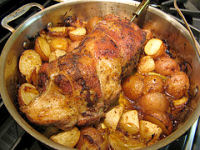 Over the last couple of days, we’ve celebrated many other “firsts.” Our inaugural breakfast included Fatted Calf bacon, perfectly fried eggs, and toasted Acme pain de mie. We made our first old favorite, the Zuni Cafe mock porchetta with roasted roots, in our new oven. And for our first new-to-us dish, I turned to a recipe that had been calling my name for weeks: Spaghetti al’ Limone from Avenue Food, which I’d printed out and squirreled away with the express idea of cooking it as soon as I could boil a pot full of water without waiting two hours.
Over the last couple of days, we’ve celebrated many other “firsts.” Our inaugural breakfast included Fatted Calf bacon, perfectly fried eggs, and toasted Acme pain de mie. We made our first old favorite, the Zuni Cafe mock porchetta with roasted roots, in our new oven. And for our first new-to-us dish, I turned to a recipe that had been calling my name for weeks: Spaghetti al’ Limone from Avenue Food, which I’d printed out and squirreled away with the express idea of cooking it as soon as I could boil a pot full of water without waiting two hours.
Last night, we made our first braise, and our first meal from our favorite cookbook — a Moroccan-esque chicken with preserved lemons and olives. Stumped for a side dish, I concocted the kitchen’s first new recipe, a jumble of veggies from this weekend’s farmers market trek and a few pantry staples. Like everything else we’ve cooked this week, it was nothing extraordinary. But the joy of making it, and the pleasure of its first-ness, were enough to keep me smiling even through the dishwashing.
 Amid all this giddy cooking, it’s easy to forget that we still have plenty of items on the punch list — including dealing with the joy(!) of knob-free doors and drawers until sometime around Easter week, when our re-made cabinet doors are due to arrive. In the meantime, we’ve got a lot of great dinners planned, a lot more hoarded recipes to try. And we’re amusing ourselves by slowly coming to grips with the fact that it’s all finally REAL. We can’t wait to share some photos (and some more meals) with you soon.
Amid all this giddy cooking, it’s easy to forget that we still have plenty of items on the punch list — including dealing with the joy(!) of knob-free doors and drawers until sometime around Easter week, when our re-made cabinet doors are due to arrive. In the meantime, we’ve got a lot of great dinners planned, a lot more hoarded recipes to try. And we’re amusing ourselves by slowly coming to grips with the fact that it’s all finally REAL. We can’t wait to share some photos (and some more meals) with you soon.
The “First” Salad
1 cup (about 1/2 can) drained garbanzo beans
1 small cucumber, diced (peeled if thick-skinned)
1 small heirloom tomato, seeded and diced (about 1/2 cup)
1/2 tsp. whole Mexican oregano, crumbled
1-1/2 tsp. chopped flat-leaf parsley
2 stalks green garlic, white and light-green parts, sliced thin
1T (or to taste) rich olive oil
juice of 1/2 Meyer lemon (about 1T)
salt and pepper, to taste
cookbooks, cooking, kitchen, recipes
15 Comments »




Posted by Anita on 01.31.07 12:04 AM
 One of the farmers at the market this weekend was selling a big-ass bag-o-roots combo — turnips, parsnips, mostly, and also some gnarly carrots — so of course I couldn’t pass that up. As I strolled the empty aisles, wondering how I would prepare my mess of veg, I remembered seeing a recipe for a creamy root vegetable soup in the market newsletter. Nobody seemed to be selling celery root, so I popped into Farm Fresh to You (after a stop at Miette, mais oui!) and picked up a knob. Mission accomplished!
One of the farmers at the market this weekend was selling a big-ass bag-o-roots combo — turnips, parsnips, mostly, and also some gnarly carrots — so of course I couldn’t pass that up. As I strolled the empty aisles, wondering how I would prepare my mess of veg, I remembered seeing a recipe for a creamy root vegetable soup in the market newsletter. Nobody seemed to be selling celery root, so I popped into Farm Fresh to You (after a stop at Miette, mais oui!) and picked up a knob. Mission accomplished!
With a minimum of chopping and sauteeing, and a little help from — don’t hate me — chicken broth from a box, we had an incredible soup that left each of us scheming for ways to get all the leftovers for ourselves. I made a double batch, and froze half of the puree (omitting the creme fraiche, which I’ll add when I thaw and reheat it), so the next batch will be even speedier.
Golden Vegetable Bisque
– adapted from Full Moon Feast by Jessica Prentice, via the CUESA newsletter
2 T fruity olive oil
1 small onion, sliced
1 small celery root (celeriac), peeled and cut into chunks
1 parsnip, cut into chunks
1 golden turnip, cut into chunks
1 carrot, cut into chunks
1 bay leaf
3 sprigs of fresh thyme
1 clove garlic, peeled and smashed
1 quart chicken stock, low-sodium chicken broth, or water
4 oz. creme fraiche (or other dairy, as you prefer)
1/8 tsp. freshly grated nutmeg
Salt and pepper to taste
Heat the oil in a medium-sized saucepan. Add the onions and sauté until tender. Add the vegetables one by one, sauteing each for a moment.
Add the stock to cover the vegetables by about half an inch. Add the herbs and garlic, cover, and bring to a boil. Reduce the heat and simmer, covered, until all is tender, about 25 minutes.
Remove the pot from the heat, and discard the bay leaf and the thyme stems. Puree the soup with an immersion blender (or in batches — carefully — in a standard blender). Add the creme fraiche, nutmeg, and a big pinch of pepper and salt. Taste the soup and adjust the seasoning. Feeling fancy? Try it with some Eatwell Farms rosemary salt.
cooking, farmers markets, recipes
5 Comments »




Posted by Anita on 12.17.06 8:39 PM
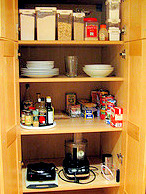 What’s your big holiday present this year? A fancy gadget? A new appliance? Maybe a fabulous cookbook? Not to brag, but I think I’ve got you beat: This year, our Christmas present to each other is a full-fledged kitchen remodel.
What’s your big holiday present this year? A fancy gadget? A new appliance? Maybe a fabulous cookbook? Not to brag, but I think I’ve got you beat: This year, our Christmas present to each other is a full-fledged kitchen remodel.
We knew the second we stepped foot in the house that’s now ours — and saw the utter disaster that was the kitchen — that a gut-job was in order. (If you clicked that link, I feel compelled to tell you that was the previous owners’ idea of tidying up for an open house.) But for the last 18 months, we’ve had more pressing remodel issues to tackle, and we also spent nearly 6 months working with a very talented architect to get all of our ‘must-have’ and ‘really-want’ items into one room while staying reasonably close to our original budget. But it’s gonna happen, boys and girls — it’s gonna happen soon.
January 2 is our scheduled start date, the day the big Irish guys show up with sledgehammers and dust masks and a big-ass Dumpster. And since this project includes not just our kitchen but also our master bathroom, we’re movin’ on down to the basement. Happily, like many SF houses, our “basement” is really the ground floor of our house, opening onto the backyard.
For the last year and a half, this space has served as our guest suite, home office, and music studio. Over the last month, we’ve worked with our kitchen contractor to turn part of it into our new laundry room and craft workshop (finally — a place for all those canning jars and infusion bottles!), a space that will serve as our makeshift kitchen during the remodel. Hence, the photo above: Our pantry-china cabinet-appliance garage-bar.
As you might imagine, I’m coping with the chaos by writing lists: A list of appliances we’ll need (toaster oven, yes. rice cooker, yes. coffeepot, yes. ice-cream maker? not so much), a list of one-dish suppers we can make in our screwball cafe… and another list of nearby restaurants that deliver.
I keep telling myself that our temporary home is larger than many apartments where we’ve lived over the years, and (sadly) that we actually have more counter space in the laundry room than we had in the old kitchen. My first college apartment lacked a kitchen entirely, and yet I cooked quite respectably — even for parties — using a microwave and a hotplate, washing dishes in the tub. Surely I can do at least as well with my current set of skills and resources. If all else fails, I’ll remember my mantra: “It’s only temporary.”
In addition to the contents of the server closet cabinet above, we’ll also have our gas grill on the deck, an incredibly expensive toaster oven, a coffee maker, and (temporarily) a big washtub in the bathroom — the kind you see in laundry rooms, but right in the shower.
cooking, equipment, holidays & occasions, kitchen
6 Comments »




Posted by Anita on 11.28.06 8:08 AM
 Tami of Running with Tweezers posted a gorgeous roasted eggplant soup recipe in honor of her mother, and invited her blog-buddies to post about their favorite soups. With a head of cauliflower in the fridge, a brisk chill in the air, and my own parents’ anniversary dinner to cook, I knew exactly which soup to share.
Tami of Running with Tweezers posted a gorgeous roasted eggplant soup recipe in honor of her mother, and invited her blog-buddies to post about their favorite soups. With a head of cauliflower in the fridge, a brisk chill in the air, and my own parents’ anniversary dinner to cook, I knew exactly which soup to share.
I first made a variation on this soup last winter as one of the last few Soup of the Fortnight installments. But it bears repeating, because although it’s based on an Epicurious recipe, you know I can’t make anything without a little (or a lot) of tinkering. Plus, it’s such a luxurious soup, and it goes so well with a wide variety of sandwiches and salads to make a satisfying supper — you might never guess how easy it is to make simply by tasting it.
Here’s my adapted recipe, perfect for a chilly evening:
Blue Cheese Cauliflower Soup
1 (1-pound) head cauliflower, cut into small florets
1/4 cup butter
1 medium onion, chopped
3/4 cup chopped celery
1/4 cup all purpose flour
3 cups chicken broth
1 cup milk, or more as needed
3 ounces Gorgonzola (or other mild blue cheese), crumbled
Ground white pepper, to taste
In a medium pot of boiling water, blanch 1 cup of the nicest-looking cauliflower florets until just tender, about 2 minutes. Drain and rinse under cold water, and set aside.
In a large, heavy saucepan, melt the butter over medium heat. Add the onion, celery, and remaining cauliflower. Cover the pan and cook, stirring frequently, until the onions are tender, not brown — about 8 minutes.
Add flour and cook for 2 minutes, stirring constantly. Add the chicken broth and 1 cup of milk, and bring to a boil. Reduce heat and cover partially. Simmer, stirring occasionally, until vegetables are tender and soup thickens — about 20 minutes.
Using an immersion blender, puree the soup until smooth. (If using a traditional blender, puree in two batches.) Thin with additional milk, if desired. Gradually add the cheese, stirring until melted. Season with salt and white pepper, to taste.
Ladle soup into bowl, and garnish with the reserved cauliflower. Serves 4.
cooking, family, other blogs, recipes, Soup o' the Fortnight
5 Comments »




 If you’ve spent any time on food blogs, I’m sure you know Barbara of Winos & Foodies — the creator of one of my favorite blog events, Hay Hay, It’s Donna Day. Barbara asked her food-blogging friends to participate in a new blog event called A Taste of Yellow by preparing a dish containing some type of yellow food. On May 16 — in honor of the Lance Armstrong Foundation’s LIVESTRONG Day — Barbara will post a roundup of the Taste of Yellow posts. She’s collected almost 30 so far!
If you’ve spent any time on food blogs, I’m sure you know Barbara of Winos & Foodies — the creator of one of my favorite blog events, Hay Hay, It’s Donna Day. Barbara asked her food-blogging friends to participate in a new blog event called A Taste of Yellow by preparing a dish containing some type of yellow food. On May 16 — in honor of the Lance Armstrong Foundation’s LIVESTRONG Day — Barbara will post a roundup of the Taste of Yellow posts. She’s collected almost 30 so far! Vij’s Turmeric Potatoes
Vij’s Turmeric Potatoes



 Here I was, feeling all smug about having cooked and eaten six days worth of local, affordable, and (dare I brag?) delicious food for the
Here I was, feeling all smug about having cooked and eaten six days worth of local, affordable, and (dare I brag?) delicious food for the  I bought more food at the grocery store than I usually do, and less from the farmers market. Sad to say, the ‘Big Organic’ producers like Earthbound Farms make it hard to walk by that $3 bag of (four!) romaine hearts when the budget’s tight. When it came down to it, I suspected the premium for farm-fresh produce would eat into the budget. I’ll be glad to leave the shrinkwrapped lettuce behind next week, though, and go back to my delicate Little Gems.
I bought more food at the grocery store than I usually do, and less from the farmers market. Sad to say, the ‘Big Organic’ producers like Earthbound Farms make it hard to walk by that $3 bag of (four!) romaine hearts when the budget’s tight. When it came down to it, I suspected the premium for farm-fresh produce would eat into the budget. I’ll be glad to leave the shrinkwrapped lettuce behind next week, though, and go back to my delicate Little Gems. Our
Our  After much hemming and hawing, I decided there aren’t enough good reasons not join in next week’s
After much hemming and hawing, I decided there aren’t enough good reasons not join in next week’s  And because some of our favorite items come from slightly further afield, we’re going to extend our challenge radius to 200 miles, from the standard 100. But mostly, when we have a choice, we’ll opt for a product grown or made as close to us as possible. We’ll also be using fruits and herbs from our own garden, so perhaps that will keep our average distance down.
And because some of our favorite items come from slightly further afield, we’re going to extend our challenge radius to 200 miles, from the standard 100. But mostly, when we have a choice, we’ll opt for a product grown or made as close to us as possible. We’ll also be using fruits and herbs from our own garden, so perhaps that will keep our average distance down. “I got nasty habits, I take tea at three
“I got nasty habits, I take tea at three But the meal that I was not-so-secretly looking forward to the most was dinner at
But the meal that I was not-so-secretly looking forward to the most was dinner at  The gorgeous soup we served for
The gorgeous soup we served for  You’d think that after torturing myself for three months, poring over recipes that I couldn’t begin to attempt without a proper kitchen, I’d be able to choose one or two candidates from a single cookbook. But there were so many delectable-sounding recipes in the copy of
You’d think that after torturing myself for three months, poring over recipes that I couldn’t begin to attempt without a proper kitchen, I’d be able to choose one or two candidates from a single cookbook. But there were so many delectable-sounding recipes in the copy of  I don’t think I consciously picked a gorgeous dish for my second recipe, but that’s certainly how Sauteed Greens and Paneer turned out. I hope you won’t think I’m being immodest when I say it looked almost as good
I don’t think I consciously picked a gorgeous dish for my second recipe, but that’s certainly how Sauteed Greens and Paneer turned out. I hope you won’t think I’m being immodest when I say it looked almost as good  As I told a
As I told a  Over the last couple of days, we’ve celebrated many other “firsts.” Our inaugural breakfast included Fatted Calf bacon, perfectly fried eggs, and toasted Acme
Over the last couple of days, we’ve celebrated many other “firsts.” Our inaugural breakfast included Fatted Calf bacon, perfectly fried eggs, and toasted Acme  Amid all this giddy cooking, it’s easy to forget that we still have plenty of items on the punch list — including dealing with the joy(!) of knob-free doors and drawers until sometime around Easter week, when our re-made cabinet doors are due to arrive. In the meantime, we’ve got a lot of great dinners planned, a lot more hoarded recipes to try. And we’re amusing ourselves by slowly coming to grips with the fact that it’s all finally REAL. We can’t wait to share some photos (and some more meals) with you soon.
Amid all this giddy cooking, it’s easy to forget that we still have plenty of items on the punch list — including dealing with the joy(!) of knob-free doors and drawers until sometime around Easter week, when our re-made cabinet doors are due to arrive. In the meantime, we’ve got a lot of great dinners planned, a lot more hoarded recipes to try. And we’re amusing ourselves by slowly coming to grips with the fact that it’s all finally REAL. We can’t wait to share some photos (and some more meals) with you soon. What’s your big holiday present this year? A fancy gadget? A new appliance? Maybe a fabulous cookbook? Not to brag, but I think I’ve got you beat: This year, our Christmas present to each other is a full-fledged kitchen remodel.
What’s your big holiday present this year? A fancy gadget? A new appliance? Maybe a fabulous cookbook? Not to brag, but I think I’ve got you beat: This year, our Christmas present to each other is a full-fledged kitchen remodel. Tami of
Tami of